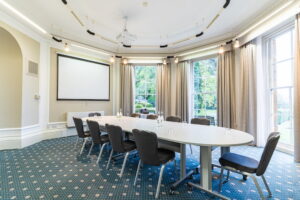
How to Run a Team Meeting | Tips to Keep Delegates Engaged
If you work in an office, chances are you attend or run regular team meetings. Meetings themselves can be really effective and engaging, but over the years they’ve gained a bad reputation. Most workers have been subjected to an unstructured, irrelevant or boring meeting which has made them feel like their time has been wasted.
But the truth is, it’s all about the delivery. Many people slip into bad habits or simply don’t know how to run a great meeting effectively. In today’s blog, we will be exploring some of the ways you can ensure your meeting is informative, engaging and powerful with some simple techniques.

Functions of a meeting
When considering how to run an effective meeting, the most important information we can give is to first think about the purpose of the meeting. How many meetings have you been in which could have been an email? Have you ever been in a meeting which wasn’t relevant to you? This all comes down to poor planning.
They should be called only when needed, inviting just the relevant meeting participants. Although this seems obvious, these good ideas are often forgotten, and people feel frustrated.
Face to face meeting are gatherings which allow delegates to share information in an interesting way which sparks discussion to solve problems. If your team are working on something, meetings are all part of project management, giving everyone the chance to get on the same page. Before you call a meeting, think about the purpose and how this is beneficial to those involved.
How to run an effective team meeting
Even internal meetings can feel like a lot of pressure, especially if you are new to them. But the truth is these can run smoothly and be highly beneficial if ran well. You don’t need to reinvent the wheel here. Following some simple mantras and avoiding easy mistakes gives you all the skills to run a team meeting effectively, and your team members will certainly thank you for it.

Team meetings agenda
Preparation is key for running a successful team meeting. Hastily called gatherings tend to be unorganised and can be a waste of time.
Ensure that both yourself and the participants have had adequate time to prepare. Make a document ahead of time with the meeting agenda, including goals and points for discussion.
Send this out to delegates to allow them to gather thoughts and prepare what they want to say. This provides them time to find any appropriate resources they might need or discussion points for an item on the agenda. Consider the amount of time you want to spend in the meeting.
A finish time is just as important as a meeting start time. Anything that goes on for too long leaves participants tapping their feet and flicking onto emails. If you need more time, consider planning another meeting or moving to a one-on-one.
Check the numbers and save time
Be aware of the number of attendees. If possible, keep numbers to as low as three to ensure everyone has a chance to speak. Ensure you are only inviting participants who really need to be there.
A long period of time spent talking about something irrelevant to one individual is a waste of their time and leads them to feel bored and demotivated. Prepare meeting minutes for anyone who might be interested in the discussion but aren’t needed in the room.
One on one meetings are inevitably more successful than large gatherings of people, where individuals are either fighting to speak or lose track of what is being said. Don’t be afraid to let people know they can leave the room if the meeting topic is changing to something irrelevant to them. They will feel more productive working on something than being in a meeting which is unrelated to them.

Pass on responsibility
The best way to make something better, particularly in the workplace, is to ask your team their opinions. Did they feel the meeting was time well spent? Was there things they would add or change?
It can be hard to judge how you’ve performed without asking your audience. Don’t be afraid to let your team lead and plan meetings.
Giving employees more responsibility boosts morale and gives them a feeling of accomplishment. This also gives you examples of other meeting techniques which you could try in your own. Experiment with different ways of running your meeting to see which is the most effective and which gets the best response.
Try team building
Meetings are not a substitute for team building. It’s great to get everyone together to catch up but a meeting isn’t the place to do this. Someone who has a deadline they could be working towards may feel that this is time wasted. Instead, take time from the workday to complete team-building activities.
This could be anything from an escape room to a classic school sports day, which is the perfect chance to get out of the office and build relationships within the workplace. These sort of events boost morale and communication which is beneficial during meetings at the office. This allows for better team collaboration and problem-solving for future projects.
How to run weekly team meetings
If you are a team leader and run weekly meetings with your employees, why not try switching things up? If the weather permits, take it outside to a quiet spot. It’s refreshing and allows the team to enjoy the meeting surrounded by nature.
The fresh air will give everyone a boost of energy and the change of scenery improves morale, allowing for better focus. Walking meetings, particularly with 2 or 3 participants work really well to integrate physical exercise into the day and make stronger personal connections, perfect for a Monday morning catch up.

How to run a team meeting conclusion
We hope you’ve enjoyed our blog on how to run a team meeting and that this has given you some ideas on how to make yours even more engaging. The working life is all about development and making your ventures even better than the last. If you are just beginning to run team meetings or you’ve been doing them for years, there is always room for improvement and growth.
Here is our summary on how to run an effective team meeting:
- Consider the function
- Prepare a team meeting agenda
- Be selective with participants
- Pass on responsibility and ask for feedback
- Don’t use meetings as catch-ups
- Try team building to boost communication in the team

If you want to change the way you run your meetings, why not try one offsite? This allows you to have the right space and facilities to make your type of meeting as effective as possible. If you are meeting with a potential client, this gives you everything you need to wow them with contemporary space and modern technology.
Our team at Sedgebrook Hall have years of experience hosting meetings and conferences, which is why we are offering meeting room hire packages to suit your requirements, with capacity for up to 200 delegates. If you need further information or would like to book your meeting room in Northampton, get in contact with our team today.
More content from our blog
Icebreakers for meetings & training seminars
8 highly-effective training techniques
Top tips for keeping employees engaged during a work meeting
Go back to other articles


